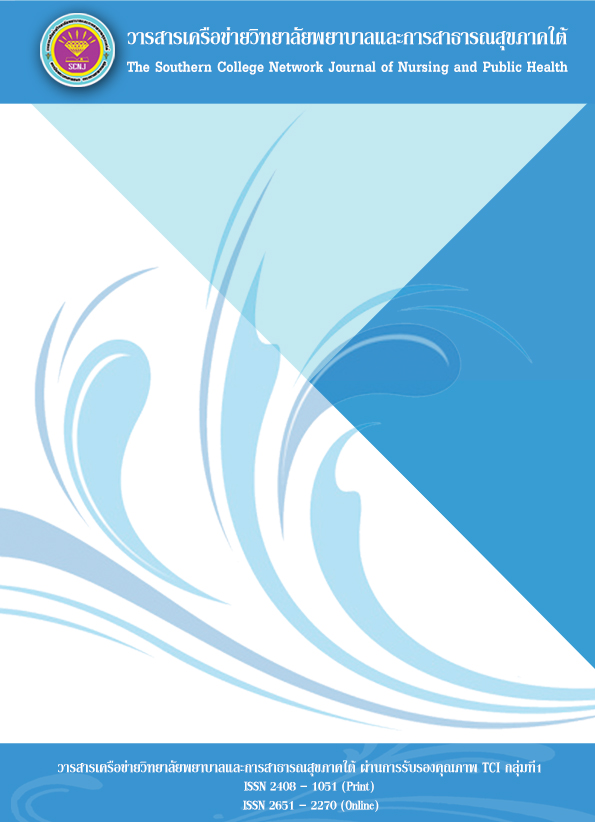ความรอบรู้ด้านสุขภาพเพื่อป้องกันโรคอ้วนของเด็กวัยรุ่นตอนต้น
คำสำคัญ:
ความรอบรู้ด้านสุขภาพ, โรคอ้วน, วัยรุ่นตอนต้นบทคัดย่อ
วิจัยเชิงพรรณนานี้มีวัตถุประสงค์เพื่อศึกษาระดับความรอบรู้ด้านสุขภาพเพื่อป้องกันโรคอ้วน และเปรียบเทียบความรอบรู้ด้านสุขภาพเพื่อป้องกันโรคอ้วนจำแนกตามเพศของเด็กวัยรุ่นตอนต้น อำเภอบัวใหญ่ จังหวัดนครราชสีมา ที่เป็นนักเรียนชั้นมัธยมศึกษาปีที่ 1 - 3 อายุ 12-15 ปี จำนวน 345 คน เป็นผู้ชาย 106 คนและผู้หญิง 239 คน เลือกสุ่มกลุ่มตัวอย่างแบบชั้นภูมิ ในแต่ละชั้นปี เก็บข้อมูลโดยใช้ แบบวัด ความรอบรู้ด้านสุขภาพเพื่อป้องกันโรคอ้วน ความเชื่อมั่นของเครื่องมือได้ เท่ากับ .89 วิเคราะห์ข้อมูลโดยใช้สถิตพรรณนาและสถิติ Independent t-test ผลการวิจัยพบว่า
ความรอบรู้ด้านสุขภาพเพื่อป้องกันโรคอ้วน ของเด็กวัยรุ่นตอนต้น อำเภอบัวใหญ่ จังหวัดนครราชสีมา อยู่ในระดับพอใช้ได้ (M=82.39, SD=3.65) เมื่อเปรียบเทียบความแตกต่างของเพศกับระดับความรอบรู้ด้านสุขภาพเพื่อป้องกันโรคอ้วน พบว่าความแตกต่างของเพศมีผลต่อความรอบรู้ด้านสุขภาพเพื่อป้องกันโรคอ้วน ของเด็กวัยรุ่นตอนต้น อำเภอบัวใหญ่ จังหวัดนครราชสีมาอย่างมีนัยสำคัญทางสถิติที่ระดับ .05 (t=-4.10, p<.05) โดยเพศหญิงมีระดับความรอบรู้ด้านสุขภาพอยู่ในระดับพอใช้ได้ (M=84.49, SD=13.23) ซึ่งมากกว่าเพศชาย ซึ่งมีระดับความรอบรู้ด้านสุขภาพอยู่ในระดับไม่ดีพอ (M=77.65, SD=16.47)
ควรมีการให้ข้อมูลเกี่ยวกับความรอบรู้ด้านสุขภาพในการป้องกันโรคอ้วนกับเด็กวัยรุ่นตอนต้นอย่างเร่งด่วน โดยเฉพาะวัยรุ่นเพศชาย โดยอาจมีความร่วมมือกับบุคลากรทางสาธารณสุข โรงเรียน ผู้ปกครองในการให้สุขศึกษา
References
Chaisang, P. (2014). Predictive Factors of Eating Behavior in Overweight High School Children. Journal of Boromarajonnani College of Nursing Nakhonratchasima, 22(1), 30-42.
Chomphuja, S. (2009). Factors Related to Eating Behavior of Students. A Thesis Submitted in Partial Fullfillment of the Requirementfor the Master of Nursing Science Degree, Faculty of Nursing, Chieng Mai University (in Thai).
Dorkkem, S. (2011). Eating Behaviors of Junior High School in Bangkok Province. A Thesis Submitted in Partial Fullfillment of the Requirement for the Master of Science Degree, Faculty of Science, NIDA, Bangkok (in Thai).
Health Education Division, Ministry of Public Health. (2014). Handbook of Health Literacy Evaluation form for Obesity Children and Adolescents. Nonthaburi: Ministry of Public Health.
Inhelder, B., Piaget, J., Pearsons, A., & Milgram, S. (1958). The Growth of Logical Thinking: From Childhood to Adolescence. New York: Basic Book.
Keawkangwan, S. (2007). Developmental of Life Time (Adolescent-Elderly). (9th.ed.). Bangkok: Thamasart University.
Kernrobkate, K. (2013). Eatting Behavior of Matthayom 2, Sattreewitthaya 2 School. A Thesissubmitted in PartialFullfillment of the Requirement for the Master of Educationaldegree, Faculty of Education, Srinakarintarawiroj University, Bangkok.
Lee, H. Y., Lee, J., & Kim, N. K. (2015). Gender Differences in Health Literacy among Korean Adults: Do Women Have a Higher Level of Health Literacy Than Men? American Journal of Men’s Health, 9(5), 370-379.
Maitaothong, T. (2012). Searching and Evaluation of Information Technology of Health Onwebsite: Trend and Analytical Research. Information Science Journal, 29(3), 31-41.
Morsuwan, L. (2013). Health Policy of Thai Children 0-5 Year of Age: Lesson from USA, Canada, Japan, Taiwan and Eastern country. Journal of Health System Research, 7(1), 168-181.
Nippanon, P. (2012). The Effect of Changing Eat Behavior to Prevent Overweight in School Agechildren at Municipal School, Nakhonratchasima. Journal of Public health KhonkhenUniversity, (Supplement), 103-114.
Nutbeam, D. (2000). Health Literacy as a Public Health Goal: a Challenge for Contemporary Health Education and Communication Strategies in to the 21st Century Department of Public Health and Community Medicine (Vol. 15). University of Sydney: Australia.
Patchana, H., Pong, J., Wanlop, J., & Jirapuk, S. (2018). Health Literacy on Cambodian Workers in Chonburi Province. The Southern College Network Journal of Nursing and Public Health, 5(2), 86-101. (in Thai)
Polit, D. F., & Hungler, B. P. (1999). Nursing Research: Principles and Methods. Philadelphia: J. B. Lippincot.
Ratchatanawin, R. (2014). Risk of Misunderstanding of Online Products. Journal of Sripratum, 15(1), 89-99.
Sararak, M., Wilabud, P., Sukuman, P., & Wongsaprom, P. (2013). Health Belief and Obesity Preventivebehaviors of Over-Nourished High School Students: A Case Study of Matthayom Trakan Phuetphon School, Ubon Ratchathani Province. Journal of Human and Social Science, 4(2), 65-85.
Sumitmaitree, B. (2003). Health Literacy Situation and Promoting Thai Health Literacy for ASEAN community. Report from DCAST: Bangkok.
Thongtang, P. (2012). Overweight in Thai Children. Rama Nursing Journal, 18, 288-295.
Tipwong, A., & Numpon, J. (2014). The Relationship Between Health Literacy of Obesity and Eatingbehavior and Exercise in Obese Children, Bangkok. Journal of Public Health Nursing, 28(2), 1-11.
Worathanarat, T. (2015). Focus on Health System. Retrived on September 22 ,2018 from https://www.hfocus.org/content/2015/05/10035.
World Health Organization. (2009). Health Literacy and Health Promotion Definition, Concepts and Example in the Eastern Mediterranean Region. Individual Empowerment Conference Working Document. 7th Global Conference on Health Promoting Health and Development. Nairobi: Kenya.
Yodpanan, C. (2012). Situation of Obesity in Children and Health Care Management. Master Thesis in Nursing Science, Graduate school, Chiang Mai University.
Downloads
เผยแพร่แล้ว
ฉบับ
บท
License
1. บทความหรือข้อคิดเห็นใด ๆ ที่ปรากฏในวารสารเครือข่าย วิทยาลัยพยาบาลและการสาธารณสุขภาคใต้ ที่เป็นวรรณกรรมของผู้เขียน บรรณาธิการหรือเครือข่ายวิทยาลัยพยาบาลและวิทยาลัยการสาธารณสุขภาคใต้ ไม่จำเป็นต้องเห็นด้วย
2. บทความที่ได้รับการตีพิมพ์ถือเป็นลิขสิทธิ์ของ วารสารเครือข่ายวิทยาลัยพยาบาลและการสาธารณสุขภาคใต้







